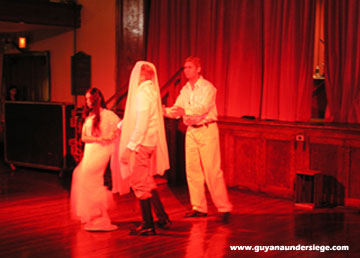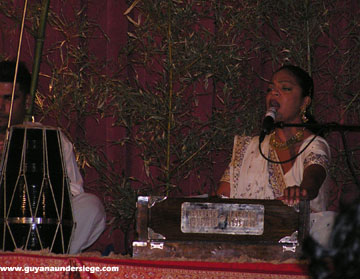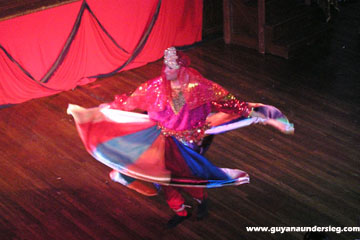| by Rakesh Rampertab |
For two days (June 10th and 11th) at the Union Congregational Church in Queens, Kitchrie—a celebration of Indo-Caribbean culture and art forms was held. I attended the Saturday sessions which were divided into two segments; a drama presentation and later that evening, a powerful display of music and dance. Kitchrie, which began in 1998 and named after an East Indian dish, is an annual Indo-Caribbean festivity promoted by the Rajkumari Cultural Center (RCC)—an organization named after its patron; the activist, poet-playwright, and radio announcer, the late Rajkumari Singh of Guyana. The Center, supported by amongst others, the Queens Council on the Arts and the New York State Council on the Arts, works to “overcome the isolation of the Indian community” in the New York Tri-State area. Skits
and Drama
The second skit is almost a monologue—spoken by Shirley (Pritha Singh), a seller at a school stall in Georgetown. Through her, we witness one day in her life; she flirts with a food vendor, is repulsed by a stuck-up local just returned from overseas; and advises a prostitute to abandon her job. But it’s the student-vagabond who avoids class, pees on the street, kicks around tin-in (aluminum can), and picks a fight—all instead of going to school, that makes the Shirley character realistic. The child not only survives the fight but even impresses the no-nonsense Shirley, who gives him a free sugar-cake before he is sent home. The virtue of this mini-drama (which reminds me of the “gas line” skit by Paul Keens Douglas) is that almost all actions and scenes occur in the imagination of the audience. There is no shortage of Indo-Caribbean events in Queens, but there is a need for more dramatic works as opposed to performance arts. This is not the first Kitchrie that I have attended, but it is the first whereby Indo-Caribbean drama is deserving of promotion beyond the confines of Queens. Kitchrie is noticeable because it is often underlined by an attempt to revive East Indian theatre—which once thrived in Guyana (In 1956, we had the Sugar Estate Drama festival) and Trinidad, beginning with religious pageant-plays such as the Ramlila, based on the Ramayana. If one studies the short dramas presented over the years by the RCC, including “Sounds of her Bells” and “Chaykay” (or “makin’ match”), there is sustained development that has culminated in these one-act plays, both of which are set on plantations in British Guiana; “Hoofbeats after Midnight” and “Sardar Birbal Singh.” In “Hoofbeats,” the daughter of a pandit, Mala (Devika Tajeshwar), commits suicide after her affair with a White lover (Rabindra Singh) (who is whipped on account of the pundit and sent back to England) raises complications. Time passes; another overseer named Malcolm (Siah Singh) sees the girl’s apparition and falls in love with it. Against a background of disbelief by the White plantation manager and others, he is tormented by the ghost’s appeal. He goes mad and accidentally dies during one of his delusions. For a moment, the manager blames the accountant (who, strangely, was East Indian [Jai Singh played by Aftab Karimullah]) for the death. But the apparition appears (it revives the dead and leads him away) before the manager who begs it to take him instead—because he (unknown to anyone until now) is the girl’s old lover who returned to the colony. It was a fitting end of a captivating play that is partially dominated by a sense of uneasiness and the unexpected.
Devika Tajeshwar, Siah Singh, and Rabibdra Singh in "Hoofbeats after Midnight." “Hoofbeats,” directed by Sharda Shakti Singh, an aspiring young director, is characterized by mystery and fear of what lurks on the plantation “after midnight.” This was emphasized by background audio sounds used, of horses terrified etc. Plantations, of course, were famous for their supernatural figures; from old higue to the bachoo to the “Dutch” man to jumbie. Adapted from a “radio play” written by Rajkumari, “Hoofbeats” is an attempt at serious drama despite its minor shortcomings such as not having a plantation setting. This, apparently, was due to the church disallowing the use of elaborate stage props and adequate lighting. Gopaul, the mule-boy (played convincingly by a young girl, Nirvana Appadu, in her first-ever role) could not have known the word “mesmerize”; it is doubtful that the pandit knew Sanskrit (which was not taken to the colonies), or cause his superior, a white overseer, to be whipped. “Sardar Birbal Singh” is based on the life of a real person that lived on Plantation Leonora. He (not one Birbal Singh who was a teacher/headmaster) became famous for his good looks, strength, and fearlessness as a sardar on the plantation—something which my grandparents (who are from Leonora) talked about. How much of his life was captured accurately by Rajkumari (and adapted by her son Varuna Singh who directed this play) is unknown—because this play, despite strong performances from Rabindra Singh (double roles; Sardar imitation and O’ Mallay, a junior overseer) and Romona Singh (Mary), seemed lacking in content. Young Siah Singh (Ronnie) was far from his excellent portrayal of the delusional Malcolm in “Hoofbeats,” because his character needed depth. Much of the Birbal Singh’s saga is told by O’ Mallay (interestingly, an Irishman dressed up in turban etc. to look like the sardar) to Mary who develops admiration for the dead Indian. The sardar has a relation with a pundit’s daughter (a repeated theme) who eventually dies during childbirth (death of daughter, another repeated theme). Caste issue puts the Brahmin pandit at odds with the sardar, who gets a good “thrashing” from the girl’s brothers. This is odd given the sardar’s stature (here is an Indian who whipped the very White overseer who had flogged him earlier). Driven from the plantation (with his companion), he dies of “frustration” and “hunger”—conditions one does not expect a man of character to succumb to.
Music and Dance
Shiv Lakhan (left) and Anand Yankarran (right) during a chutney duet.
Young Anjali Pare doing a Kanchan "chutney" number. Now the RCC dancers—Romona Singh, Devika Tajeshwar, Seema Tiwari, Denyse Baboolal, and Romanee Kalicharran, are talented young Indian women all of whom I have been told, have at least their first degree—and still engage in drama and dancing. Ms. Kalicharran, who has also evolved as a choreographer, is an established dancer in the community where most “dancers” simply entertain, while a rare handful actually dances. So many “dancers” today (aptly described at times as some kind of “sensation”), lack a dance philosophy, and this is evident in their mannerism on stage. They are mannequins that make hastas (hand gestures), unsupported by the finesse of dance history; they often seem too conscious of being onstage and end up more as “show offs.” The dancer becomes an exhibitionist. And this is not even touching on East Indians who confuse technique with vulgarity—as was exhibited recently at City Hall (Guyana’s 39th Independence celebration) by a little girl (and I mean little) who was made to “wine” on the floor of the chambers.
Loundwa Ki Nauch dancer from Suriname-Holland. It is true that East Indian dance is not a straight-jacketed affair. It is true that Matikor dancing indulges in semi-lewd mannerism; but that comes out of an ancient tradition of ribaldry which is not promoted beyond the Matikor and transformed as public fashion. And, it is appealing that while the RCC apparently recognizes that flexibility is needed for any art form to evolve, the dances at Kitcheri 2005 have avoided any defamation of traditions. And this, I feel, ought to be noted since it is not easy to stage Indian dance and drama out of the nude. But on Saturday night, it was the imported Loundwa Ki Nauch dancer from Suriname-Holland, who brought a sense of newness to Kitcherie 2005. Quite different from the traditional classical dance styles we’re familiar with—kathakaki, Bharat Natyam, etc., and certainly a contrast to the folk dances by the RCC dancers in their rich, Caribbean cotton outfits or colorful saris, the attire of the Surinamese dancer (a man dressed as a woman) included an extravagant skirt made of bright stripes of colors stitched vertically so as to create spirals when the dancer spins. Quite uncommon these days, this style of dance seemingly is characterized by swirls that resemble the dance of dervishes, and of course, early public dance in East Indian villages where men would dress as women and dance. Photography
and Crafts Whatever the shortcoming of the booths, it was overshadowed by the display of almost two dozen photographs of early East Indian life in British Guiana (a few from Suriname also), especially during the forties and fifties; from a Kali-worshipping ceremony in the cane fields, to a missionary school, to a “Tajah” festival, to the cast of the first performance of the play “Savitri” (one of the first East Indian plays produced in the British Caribbean), to Maselall Pollard, sitar maestro playing an instrument that has become extinct in Guyana—it is an interesting gathering of East Indian history that is hard to find today. I wish, therefore, to applaud the RCC for safeguarding these invaluable relics and sharing them with the community. I wish to encourage the East Indian community in Queens to engage the RCC and, at the least, expose their children to the rich traditions one may find there. I also wish to encourage the RCC to continue its excellent work, and to take its performance outside of Queens—perhaps the Asia Society and, of course, the Bronx where the substantial East Indian community is often forgotten from Spotlight TV to the Phagwah parade. If we are going to “overcome isolation” through Indo-Caribbean culture, it has to be presented where the isolation is the greatest.
|
| June 20th, 2005 |
©
2001 Guyanaundersiege.com |




